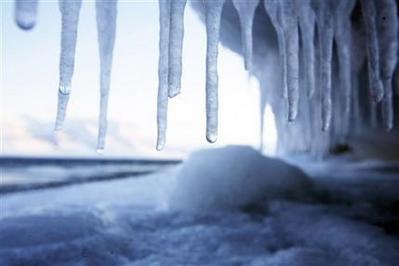
Coastal ice melts in the city of Longyearbyen, in Norway's Svalbard Islands, on Feb. 27, 2008. Record-high temperatures have left people here wondering whether the melting ice is all a fluke in the fluctuating weather system, or a troubling sign of a warming world. (AP Photo/John McConnico) Full story here http://hosted.ap.org/dynamic/stories/N/NORDICS_WARM_WINTER?SITE=RIPAW&SECTION=HOME&TEMPLATE=DEFAULT
Energy efficiency---using improved technology and operations to deliver the same energy services with less fuel---is the foundation on which all of our other recommendations are based.
---Sierra Club Energy Policy Statement
When you do something, you should burn completely, like a good bonfire, leaving no trace of yourself.
---Shunryu Suzuki
My religion is to live and die without regret.
---Milarepa
The March-April newsletter of the Appalachian Ohio Group of the Sierra Club is out. A feature article in Footnotes From The Foothills this time was written by my wife to describe weatherization work she initiated on our house last summer. It was a major operation, employed 3 different workcrews (sometimes all at once) and cost a lot. There's a teeny tax credit you can get for this stuff, but mostly we did it to reduce our footprint and hopefully save money in the long run.
Energy Efficiency MakeoverBy Dana Carlson
Last summer, we bit the bullet. Our circa 1969 ranch house needed a new roof and gutters at the very least---and with the drought already well under way in May 2007, it seemed prudent to think about rainwater catchment.
Other droughts we'd been through in our 10 years here have meant cutting back significantly on water use to avoid a dry well: doing laundry in town, using grey water for flushing toilets, letting the garden dry up, washing dishes in a gallon of water, 'showering' with a couple of gallons in a portable camp shower.
We finally invested in a couple of stock tanks to fill with water from a small seasonal stream by the garden so that we could have some water resources for the garden during dry times, but that was spit in a bucket during a drought like '07. We were near to paying off our mortgage and, after some discussion of the pros and cons, decided that we'd suck it up and take out a home equity loan---as long as we were having the roof done, we might as well put our money where our environmental sensibilities were and get an energy audit and retrofit.
My brother recommended R.W. Davis to do the work. R.W. had saved our lives back when we'd moved into the house: the furnace was suspect and we'd had him check it. His machine detected dangerous levels of carbon monoxide, so he'd installed a high-efficiency propane furnace at that time. He also told us we should do some weatherization of the ducts and crawl space. R.W. had previously worked with COAD Corporation for Ohio Appalachian Development), and in the ten years since installing the furnace, he'd formed an energy audit/weatherization business called ECS Group.
After a walk-through of the house (checking insulation, windows, etc.), he did a blower door test (to detect leakage) and gave us a workup of possible fixes using the NEAT (National Energy Audit Tool) software to determine the most cost-effective retrofits.
We ended up having the crawl space sealed with two-part foam ($2200), the ductwork sealed ($225), air seal bandjoists ($550), cellulose insulation blown in the attic ($950), low-flow showerheads installed, a timer put on the water heater, new bathroom fans, and sealing around electrical sockets and ceiling lights. We also had two ultra low-flow Toto toilets put in ($600 each).
R.W. and I also tossed around the idea of replacing the windows and five sets of sliding glass doors. He suggested framing in at least two doors and putting smaller windows in to save significantly on energy loss. We contracted with Quality Windows (Pomeroy) to have all the windows/doors replaced with R10 triple pane vinyl windows.
This was the most expensive retrofit at $18,000, including a 9' three panel sliding door, two 6' sliding doors, 20 windows and two 6' doors framed in. Finally, at the same time the roof and gutters were redone, we had the gutters re-routed to empty into a 450 gallon water tank on one side of the house and a 550 gallon tank under the deck for rainwater catchment. This water can be used for the garden and toilets, and if necessary, filtered for drinking.
We made the decision to have this work done for environmental reasons--- we wanted to significantly decrease our use of carbon-based energy and, of course, we wanted to save money on utility bills.
We'd had a solar-wind power evaluation done and were told neither one would be suitable for our poorly solar-sited house, so weatherization was our option.
The good news is that our propane consumption has decreased by almost half. Our electrical use has also decreased significantly--- thanks to use of compact fluorescents and using power strips to turn off phantom loads--- and using drying racks in the winter and clotheslines in the summer instead of the dryer. We expect to recoup the money we put into the retrofit within 10 years, probably sooner, if energy prices climb as expected.

No comments:
Post a Comment